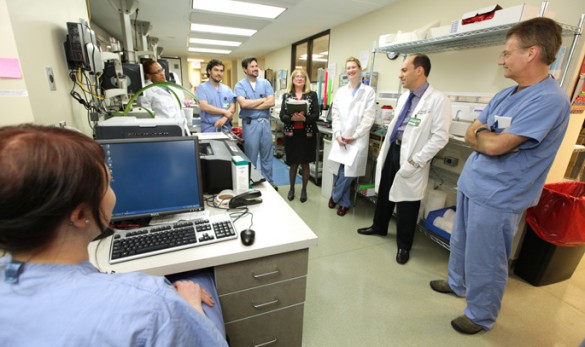
Surgical pathologists are often asked to evaluate tissue samples mid-procedure. These intraoperative consultations entail rapid processing and microscopic evaluation to distinguish diseased tissue from healthy tissue, thus helping guide the surgeon’s hands.
At Vanderbilt University Hospital, this pressurized, time-sensitive task, called a frozen section procedure, is the work of a team comprised of Pathology technicians, pathologist assistants, a Pathology fellow and a surgical pathologist. They evaluate the tissue, produce frozen section slides, review and interpret these slides and immediately communicate the findings back to the operating room.
According to Omar Hameed, M.D., medical director of Surgical Pathology and associate professor of Pathology, Microbiology and Immunology and Urologic Surgery, frozen sections are a good place to focus patient safety and quality improvement efforts.
Along with Hospital Medicine and Vanderbilt Medical Group Administration, Surgical Pathology was one of three groups selected for the 2012-13 Vanderbilt Quality and Patient Safety Pioneer Program. Supported by the Office of Quality and Patient Safety, the Pioneer Program is a yearlong immersion in safety science and system improvement. The program is a key component of Vanderbilt University Medical Center’s efforts to foster an organizational culture of patient safety, quality and reliability.
“We have a very active quality management program in Surgical Pathology, and we saw the Pioneer Program as an opportunity to get access to additional resources and complement what we’re doing in this regard. Experts have introduced us to the concept of high reliability and provided a framework and resources to help us look at our processes in more detail, define goals and mount further quality improvements,” Hameed said.
VUH Surgical Pathology includes approximately 120 pathologists, residents/fellows, assistants, technicians and administrators. A representative group of 20 faculty and staff, led by Hameed and Joe Musselman, director of Anatomic Pathology, participated in the Pioneer Program’s five half-day learning sessions and transmitted the content to the larger group. Other facets of the Pioneer Program include weekly team meetings, coaching by experts (both from within Vanderbilt and from outside the university) and support for project management, data acquisition and analysis. The changes mounted in Surgical Pathology centered on enhancement of teamwork and the safety culture, and developing high reliability in provider communication and specimen handling.
After mapping the specimen handling process and identifying potential vulnerabilities, Hameed and colleagues settled on the VUH gross room, particularly frozen sections, as the focus. The main changes have included a more flexible scheduling plan for frozen section coverage, standardized communication, standardized specimen handoffs, and a daily gross room team briefing/debriefing to review the day’s expected activity and the prior day’s work.
“In addition to making the team more prepared for the day, the briefing/debriefing is a place for everyone to contribute ideas and suggestions. These are usually translated into action items and improvement projects or forwarded to other areas in Surgical Pathology for further action. Furthermore, these meetings help us get to know each other better, which is known to enhance teamwork and communication and, accordingly, quality and patient safety. Although such meetings are well established in other clinical settings, they are quite novel in surgical pathology, especially meetings that include all team members in the gross room,” Hameed said.
“In medicine we don’t necessarily train people to interact openly with others. If we’re going to aspire to the high reliability found in industries like aviation and nuclear power, we need to make more open interaction between different clinical teams and among team members a high priority.”
With the improvements in the gross room expanding to other areas of Pathology, Hameed believes that the Pioneer Program has brought Surgical Pathology closer to its goal of zero errors.
For more information on the Pioneer Program, visit the website.












